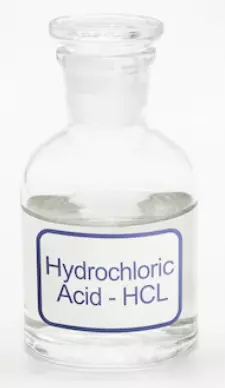IUPAC Name
Chlorane
Cas Number
7647-01-0
HS Code
2806.10.00
Formula
HCl
Appearance
Colorless to Slightly Yellow Gas/Liquid
Common Names
Muriatic Acid, Chlorane
Packaging
(275 KG UN Approved HDPE Drums, 22 MT), (290KG new HDPE Drums packed loose and placed on standard plywood, 23.20 MT)
Hydrochloric acid is a clear, colorless, highly pungent solution of hydrogen chloride (HCl) in water. It is a highly corrosive acid with many industrial uses. It is a monoprotic acid and is less likely to undergo an interfering oxidation-reduction reaction than other industrial acids. Despite its acidity, it is one of the least hazardous strong acids to handle, as it contains the non-reactive and non-toxic chloride ion. Intermediate-strength hydrochloric acid solutions are quite stable upon storage, and their concentrations are maintained over time. These attributes, together with the fact that it is available as a pure reagent, make hydrochloric acid an excellent acidifying reagent.
The simplest method for producing Hydrochloric Acid is direct synthesis from the elements, hydrogen (H) and chlorine (Cl), which yields a very pure product. Industrial production involves the use of a burner. Chlorine and hydrogen are fed by separate concentric tubes into the combustion chamber. After ignition, the chlorine burns in the hydrogen at more than 2000∘C. A cooling section is connected to the combustion chamber to collect the hydrogen chloride formed.
Hydrochloric acid is a clear, colorless, highly pungent solution of hydrogen chloride (HCl) in water. It is a highly corrosive acid with many industrial uses. It is a monoprotic acid and is less likely to undergo an interfering oxidation-reduction reaction than other industrial acids. Despite its acidity, it is one of the least hazardous strong acids to handle, as it contains the non-reactive and non-toxic chloride ion. Intermediate-strength hydrochloric acid solutions are quite stable upon storage, and their concentrations are maintained over time. These attributes, together with the fact that it is available as a pure reagent, make hydrochloric acid an excellent acidifying reagent.
The simplest method for producing Hydrochloric Acid is direct synthesis from the elements, hydrogen (H) and chlorine (Cl), which yields a very pure product. Industrial production involves the use of a burner. Chlorine and hydrogen are fed by separate concentric tubes into the combustion chamber. After ignition, the chlorine burns in the hydrogen at more than 2000∘C. A cooling section is connected to the combustion chamber to collect the hydrogen chloride formed.
